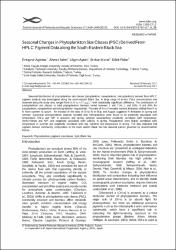Seasonal changes in phytoplankton size classes (PSC) derived from HPLC pigment data along the South-Eastern Black Sea
Citation
Ağırbaş, E., Şahin, A., Aytan, Ü., Koral, S. & Fidan, D. (2017). Seasonal Changes in Phytoplankton Size Classes (PSC) Derived From HPLC Pigment Data along the South-Eastern Black Sea. Turkish Journal of Fisheries and Aquatic Sciences, 17, 1449-1465. https://doi.org/10.4194/1303-2712-v17_6_39Abstract
Seasonal distribution of phytoplankton size classes (picoplankton, nanoplankton, microplankton) derived from HPLC pigment analysis was investigated along the south-eastern Black Sea. A large range of in-situ Chl-a concentrations was observed along the study area, ranged from 0.35 to 4.57 mu g.l(-1) with statistically significant difference. the contribution of phytoplankton size classes to total phytoplankton biomass varied between 1 and 71%; 1 and 92%; 8 and 93% for picoplankton, nanoplankton and microplankton, respectively. the ratio of N to P revealed nutrient limitation shifted from P to N from summer to autum. An increase in the ratio of Si to N in May and August suggested N limitation in spring and summer. Canonical correspondence analysis revealed that microplankton were found to be positively associated with temperature, Chl-a and N/P in autumun and spring, whereas nanoplankton positively correlated with temperature, nitrite+nitrate and N/P, and negatively associated with salinity in spring. Picoplankton were highly correlated with temperature in summer and negatively correlated with key nutrients and temperature in spring. the data indicated that pigment derived community composition in the south eastern Black Sea has seasonal pattern governed by environmental factors.


















